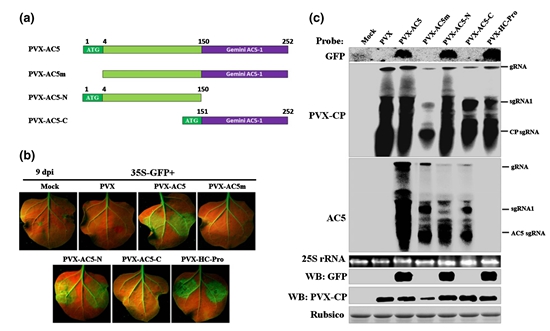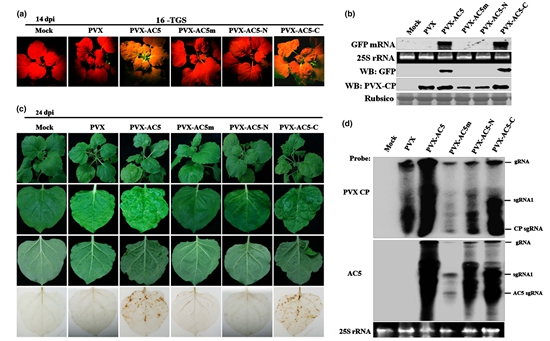分享到
The AC5 Protein Encoded by Mungbean Yellow Mosaic India Virus is a Pathogenicity Determinant that Suppresses RNA Silencing-based Antiviral Defenses
The molecular features of begomovirus genomes have been thoroughly characterized, with the functions of most genes being well understood. Although an increasing number of begomoviruses have been annotated to contain an AC5/C5 ORF, little is known regarding its function during virus infection. Recently, the scientist in the Institute of Plant Protection has made a great progress in research on the function of the AC5 protein. the related research results have been published in New Phytologist.
It is generally accepted that begomoviruses in the family Geminiviridae encode four proteins (from AC1/C1 to AC4/C4) using the complementary-sense DNA as template. Although AC5/C5 coding sequences are increasingly annotated in databases for many begomoviruses, the evolutionary relationships and functions of this putative protein in viral infection are obscure. In this study, the scientists in IPP-CAAS demonstrated several important functions of the AC5 protein of a bipartite begomovirus, Mungbean yellow mosaic India virus (MYMIV). Comparison of wild-type and ac5 mutant MYMIV viruses demonstrated that AC5 had a critical role in infection. Furthermore, they confirmed that AC5 activity affected symptom phenotypes, and suppressed both PTGS and TGS. The results demonstrated that MYMIV AC5 was a pathogenicity determinant and a potent RNA silencing suppressor that employed novel mechanisms to suppress antiviral defenses, and suggested that the AC5 function may be conserved among many begomoviruses.

The AC5 N-terminal domain suppresses post-transcriptional gene silencing (PTGS)

The AC5 C-terminal domain is responsible for transcriptional gene silencing (TGS) suppression, severe symptoms and necrotic responses
It is generally accepted that begomoviruses in the family Geminiviridae encode four proteins (from AC1/C1 to AC4/C4) using the complementary-sense DNA as template. Although AC5/C5 coding sequences are increasingly annotated in databases for many begomoviruses, the evolutionary relationships and functions of this putative protein in viral infection are obscure. In this study, the scientists in IPP-CAAS demonstrated several important functions of the AC5 protein of a bipartite begomovirus, Mungbean yellow mosaic India virus (MYMIV). Comparison of wild-type and ac5 mutant MYMIV viruses demonstrated that AC5 had a critical role in infection. Furthermore, they confirmed that AC5 activity affected symptom phenotypes, and suppressed both PTGS and TGS. The results demonstrated that MYMIV AC5 was a pathogenicity determinant and a potent RNA silencing suppressor that employed novel mechanisms to suppress antiviral defenses, and suggested that the AC5 function may be conserved among many begomoviruses.

The AC5 N-terminal domain suppresses post-transcriptional gene silencing (PTGS)

The AC5 C-terminal domain is responsible for transcriptional gene silencing (TGS) suppression, severe symptoms and necrotic responses
This work was supported by grants from the National Natural Science Foundation of China (31390422 and U1136606), the National Key Basic Research and Development Program of China (2012CB114004) and the Zhejiang Provincial Natural Science Foundation for Outstanding Young Scientists (LR12C14001).
For more information, please visit:
http://onlinelibrary.wiley.com/doi/10.1111/nph.13473/full
For more information, please visit:
http://onlinelibrary.wiley.com/doi/10.1111/nph.13473/full
Latest News
-
 Apr 18, 2024Opening Ceremony of the Training Workshop on Wheat Head Scab Resistance Breeding and Pest Control in Africa Held in CAAS
Apr 18, 2024Opening Ceremony of the Training Workshop on Wheat Head Scab Resistance Breeding and Pest Control in Africa Held in CAAS -
 Apr 03, 2024IPPCAAS Co-organized the Training Workshop on Management and Application of Biopesticides in Nepal
Apr 03, 2024IPPCAAS Co-organized the Training Workshop on Management and Application of Biopesticides in Nepal -
 Mar 28, 2024Delegation from the School of Agriculture and Food Science of University College Dublin, Ireland Visit to IAS, CAAS
Mar 28, 2024Delegation from the School of Agriculture and Food Science of University College Dublin, Ireland Visit to IAS, CAAS -
 Mar 25, 2024Director of World Food Prize Foundation visited GSCAAS
Mar 25, 2024Director of World Food Prize Foundation visited GSCAAS -
 Mar 20, 2024Institute of Crop Sciences (ICS) and Syngenta Group Global Seeds Advance Collaborative Research in the Seed Industry
Mar 20, 2024Institute of Crop Sciences (ICS) and Syngenta Group Global Seeds Advance Collaborative Research in the Seed Industry
